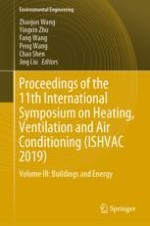2020 | OriginalPaper | Buchkapitel
A Simplified Dynamic Model of Roof Integrated with Shape-Stabilized Phase Change Material
verfasst von : Qingchen Yang, Jinghua Yu, Junchao Huang, Shan Peng, Junwei Tao
Erschienen in: Proceedings of the 11th International Symposium on Heating, Ventilation and Air Conditioning (ISHVAC 2019)
Verlag: Springer Singapore
Aktivieren Sie unsere intelligente Suche, um passende Fachinhalte oder Patente zu finden.
Wählen Sie Textabschnitte aus um mit Künstlicher Intelligenz passenden Patente zu finden. powered by
Markieren Sie Textabschnitte, um KI-gestützt weitere passende Inhalte zu finden. powered by
